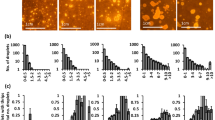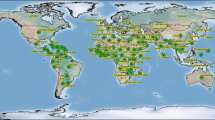Abstract
Green peach aphid (GPA), Myzus persicae, is a major pest of most horticulture crops. Chitosan-based pest management emerges as an alternative to pesticides due to its biocompatibility and biodegradability properties. Population growth and electrical penetration graph (EPG)-based feeding behavior studies were conducted to assess the effect of chitosan application on caisim against GPA at three concentrations (0.1%, 0.5%, and 1%) including two controls of water and acetic acid. Evident GPA population growth reduction was observed in the chitosan-treated caisim. The effect of chitosan was further monitored by 10 h of EPG recording, which revealed a significant increase in probing activities due to frequent stylet withdrawal that generated high levels of short probing activities. Additionally, inter- and intracellular stylet punctures (waveform C and potential drop-Pd, respectively) displayed a significant increase. However, once the stylet reached the phloem tissue, GPA under chitosan treatment and water control can access the phloem tissue equally, either in terms of the number and duration. Therefore, we suggest that the reduced population growth due to chitosan treatment was related to extra energy consumption during frequent stylet withdrawal and intracellular puncture. This finding indicates the role of chitosan as a plant defense elicitor. However, further investigation regarding this topic is required.
Similar content being viewed by others
Data Availability
All relevant data are within the paper.
References
Backus EA, Guedes RNC, Reif KE (2020) AC–DC electropenetrography: fundamentals, controversies, and perspectives for arthropod pest management. Pest Manag Sci. https://doi.org/10.1002/ps.6087
Badawy ME, Rabea EI, Steurbaut W, Rogge TM, Stevens CV, Smagghe G (2005) Insecticidal and growth inhibitory effects of new O-acyl chitosan derivatives on the cotton leafworm Spodoptera littoralis. Commun Agric Appl Biol Sci 70:817–821
Badawy MEI, Rabea EI (2011) A biopolymer chitosan and its derivatives as promising antimicrobial agents against plant pathogens and their applications in crop protection. Int J Carbohydr Chem 2011:1–29
Barribeau SM, Sok D, Gerardo NM (2010) Aphid reproductive investment in response to mortality risks. BMC Evol Biol 10:251
Cao HH, Liu HR, Zhang ZF, Liu TX (2017) Corrigendum: the green peach aphid Myzus persicae perform better on pre-infested Chinese cabbage Brassica pekinensis by enhancing host plant nutritional quality. Sci Rep 7:43076. https://doi.org/10.1038/srep43076
Capinera JL (2008) Green Peach aphid, Myzus persicae (Sulzer)(Hemiptera: Aphididae) Encyclopedia of Entomology:1727–1730
Civolani S, Marchetti E, Chicca M, Castaldelli G, Rossi R, Pasqualini E, Dindo ML, Baronio P, Leis M (2010) Probing behaviour of Myzus persicae on tomato plants containing Mi gene or BTH-treated evaluated by electrical penetration graph. Bull Insectology 63:265–271
Davis JA, Radcliffe EB, Ragsdale DW (2006) Effects of high and fluctuating temperatures on Myzus persicae (Hemiptera: Aphididae) Environ Entomol 35:1461–1468
Davis JA, Radcliffe EB, Ragsdale DW (2007) Resistance to green peach aphid, Myzus persicae (Sulzer), and potato aphid, Macrosiphum euphorbiae (Thomas), in potato cultivars. Am J Potato Res 84:259–269
De Backer L, Wäckers FL, Francis F, Verheggen FJ (2015) Predation of the Peach Aphid Myzus persicae by the mirid Predator Macrolophus pygmaeus on Sweet Peppers: effect of Prey and Predator Density. Insects 6:514–523. https://doi.org/10.3390/insects6020514
Down RE, Ford L, Woodhouse SD, Davison GM, Majerus ME, Gatehouse JA, Gatehouse AM (2003) Tritrophic interactions between transgenic potato expressing snowdrop lectin (GNA), an aphid pest (peach-potato aphid; Myzus persicae (Sulz.) and a beneficial predator (2-spot ladybird; Adalia bipunctata L.). Transgenic Res 12:229–241. https://doi.org/10.1023/a:1022904805028
El Hadrami A, Adam LR, El Hadrami I, Daayf F (2010) Chitosan in plant protection. Mar Drugs 8:968–987
Farag SMA, Elhalag KMA, Hagag MH, Khairy ASM, Ibrahim HM, Saker MT, Messiha NAS (2017) Potato bacterial wilt suppression and plant health improvement after application of different antioxidants. J Phytopathol 165:522–537
Ferreira P TP et al (2019) Prolonged mosquitocidal activity of Siparuna guianensis essential oil encapsulated in chitosan nanoparticles. PLoS Negl Trop Dis 13:e0007624
Fitza KN, Payn K, Steenkamp ET, Myburg AA, Naidoo S (2013) Chitosan application improves resistance to Fusarium circinatum in Pinus patula. S Afr J Bot 85:70–78
Goussain MM, Prado E, Moraes JC (2005) Effect of silicon applied to wheat plants on the biology and probing behaviour of the greenbug Schizaphis graminum (Rond.)(Hemiptera: Aphididae). Neotrop Entomol 34:807–813
Harrington R, Bartlet E, Riley DK, ffrench-Constant RH, Clark SJ, (1989) Resurgence of insecticide-resistant Myzus persicae on potatoes treated repeatedly with cypermethrin and mineral oil. Crop Prot 8:340–348
Huang X, Liu D, Cui X, Shi X (2018) Probing behaviors and their plasticity for the aphid Sitobion avenae on three alternative host plants. PloS One 13
Jia X, Meng Q, Zeng H, Wang W, Yin H (2016) Chitosan oligosaccharide induces resistance to tobacco mosaic virus in Arabidopsis via the salicylic acid-mediated signalling pathway. Sci Rep 6:26144
Katiyar D, Hemantaranjan A, Singh B, Bhanu AN (2014) A future perspective in crop protection: chitosan and its oligosaccharides. Adv Plants Agric Res 1:1–8
Kennedy JS, Day MF, Eastop VF (1962) A conspectus of aphids as vectors of plant viruses A conspectus of aphids as vectors of plant viruses
Lee Y, Kim H, Kang TJ, Jang Y (2012) Stress response to acoustic stimuli in an aphid: A behavioral bioassay model. Entomol Res 42:320–329
Li Y, Xu Z, Shi L, Shen G, He L (2016) Insecticide resistance monitoring and metabolic mechanism study of the green peach aphid, Myzus persicae (Sulzer) (Hemiptera: Aphididae), in Chongqing. China Pestic Biochem Physiol 132:21–28. https://doi.org/10.1016/j.pestbp.2015.11.008
Mohammed AA, Kadhim JH, Kamaluddin ZNA (2018) Selection of highly virulent entomopathogenic fungal isolates to control the greenhouse aphid species in Iraq Egypt. J Biol Pest Control 28:71
Mwaheb MAMA et al (2017) Synergetic suppression of soybean cyst nematodes by chitosan and Hirsutella minnesotensis via the assembly of the soybean rhizosphere microbial communities. Biol Control 115:85–94
Orzali L, Corsi B, Forni C, Riccioni L (2017) Chitosan in agriculture: a new challenge for managing plant disease Biological activities and application of marine polysaccharides:17–36
Paprocka M, Gliszczyńska A, Dancewicz K, Gabryś B (2018) Novel hydroxy-and epoxy-cis-jasmone and dihydrojasmone derivatives affect the foraging activity of the peach potato aphid Myzus persicae (Sulzer)(Homoptera: Aphididae). Molecules 23:2362
Pascal T, Pfeiffer F, Kervella J, Lacroze JP, Sauge MH, Weber W (2002) Inheritance of green peach aphid resistance in the peach cultivar ‘Rubira’ Plant Breed 121:459–461
Patel S, Awasthi A, Tomar R (2004) Assessment of yield losses in mustard (Brassica juncea L.) due to mustard aphid (Lipaphis erysimi Kalt.) under different thermal environments in Eastern Central India. Appl Ecol Environ Res 2:1–15
Prado E, Tjallingii WF (2007) Behavioral evidence for local reduction of aphid-induced resistance. J Insect Sci 7:48
Rubiano-Rodriguez JA, Fuentes-Contreras E, Figueroa CC, Margaritopoulos JT, Briones LM, Ramirez CC (2014) Genetic diversity and insecticide resistance during the growing season in the green peach aphid (Hemiptera: Aphididae) on primary and secondary hosts: a farm-scale study in Central Chile. Bull Entomol Res 104:182–194. https://doi.org/10.1017/S000748531300062X
Sahab A, Waly A, Sabbour M, Nawar LS (2015) Synthesis, antifungal and insecticidal potential of chitosan (CS)-g-poly (acrylic acid)(PAA) nanoparticles against some seed borne fungi and insects of soybean. Int J ChemTech Res 8:589–598
Sarria E, Cid M, Garzo E, Fereres A (2009) Excel Workbook for automatic parameter calculation of EPG data. Comput Electron Agric 67:35–42
SAS I (2008) SAS/STAT 9.2 user’s guide. SAS Institute, Cary, NC
Shim J, Park J, Paik W, Lee Y (1977) Studies on the life history of green peach aphid, Myzus persicae Sulzer (Homoptera). Korean J Appl Entomol 16:139–144
Shi Q, George J, Krystel J, Zhang S, Lapointe SL, Stelinski LL, Stover E (2019) Hexaacetyl-chitohexaose, a chitin-derived oligosaccharide, transiently activates citrus defenses and alters the feeding behavior of Asian citrus psyllid Horticulture research 6:1–10
Silva AX, Bacigalupe LD, Luna-Rudloff M, Figueroa CC (2012) Insecticide resistance mechanisms in the green peach aphid Myzus persicae (Hemiptera: Aphididae) II: Costs and benefits. PLoS One 7:e36810. https://doi.org/10.1371/journal.pone.0036810
Silva-Filho R, Santos RH, Tavares Wde S, Leite GL, Wilcken CF, Serrao JE, Zanuncio JC (2014) Rice-straw mulch reduces the green peach aphid, Myzus persicae (Hemiptera: Aphididae) populations on kale, Brassica oleracea var. acephala (Brassicaceae) plants. PLoS One 9:e94174. https://doi.org/10.1371/journal.pone.0094174
Soffan A, Aldawood AS (2015) Electrical Penetration Graph monitored feeding behavior of cowpea aphid, Aphis craccivora Koch.(Hemiptera: Aphididae), on faba bean, Vicia faba L.(Fabaceae), cultivars Turkish. Entomol Derg-Tu 39:401–411. https://doi.org/10.16970/ted.16177
Tang QL, Ma KS, Hou YM, Gao XW (2017) Monitoring insecticide resistance and diagnostics of resistance mechanisms in the green peach aphid, Myzus persicae (Sulzer) (Hemiptera: Aphididae) in China. Pestic Biochem Physiol 143:39–47. https://doi.org/10.1016/j.pestbp.2017.09.013
Tjallingii WF (1990) Continuous recording of stylet penetration activities by aphids. In: Campbell RK, Eikenbary RD (eds) Aphid–plant genotype interactions. Elsevier, Amsterdam, pp 89–99
Wang XY, Yang ZQ, Shen ZR, Lu J, Xu WB (2008) Sublethal effects of selected insecticides on fecundity and wing dimorphism of green peach aphid (Hom., Aphididae). J Appl Entomol 132:135–142
Will T, Vilcinskas A (2015) The structural sheath protein of aphids is required for phloem feeding. Insect Biochem Mol Biol 57:34–40
Yu Y, Shen G, Zhu H, Lu Y (2010) Imidacloprid-induced hormesis on the fecundity and juvenile hormone levels of the green peach aphid Myzus persicae (Sulzer). Pestic Biochem Physiol 98:238–242
Vu VH, Hong SI, Kim K (2007) Selection of Entomopathogenic Fungi for Aphid Control. J Biosci Bioeng 104:498–505
Acknowledgments
We gratefully thank the support from Applied entomology Laboratory, of Plant Protection Department, Faculty of Agriculture, Universitas Gadjah Mada, and Economic Entomology Research Unit, King Saud University for accessing and utilizing necessary facilities related to EPG monitoring. This study is part of under graduate thesis for Varsha Salsabillah.
Funding
This study was supported by Faculty of Agriculture research funding. The funders had no role in the study design, data collection and analysis, decision to publish, or preparation of the manuscript.
Author information
Authors and Affiliations
Corresponding author
Ethics declarations
Conflicts of interest/Competing interests
The authors declare that they have no conflicts of interest.
Rights and permissions
About this article
Cite this article
Salsabillah, V., Putra, N.S., Aldawood, A.S. et al. Increased probing activities of green peach aphid (GPA), Myzus persicae, on chitosan-treated caisim (Brassica juncea) monitored by electrical penetration graph (EPG). Int J Trop Insect Sci 41, 2805–2810 (2021). https://doi.org/10.1007/s42690-021-00461-3
Received:
Accepted:
Published:
Issue Date:
DOI: https://doi.org/10.1007/s42690-021-00461-3




